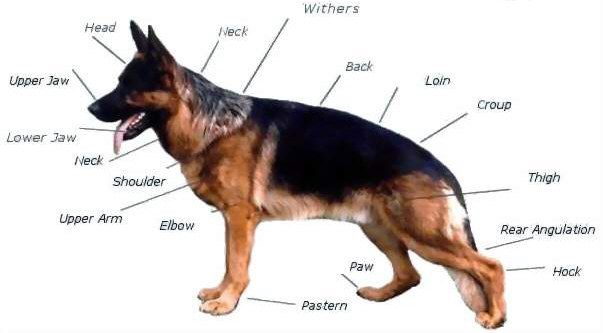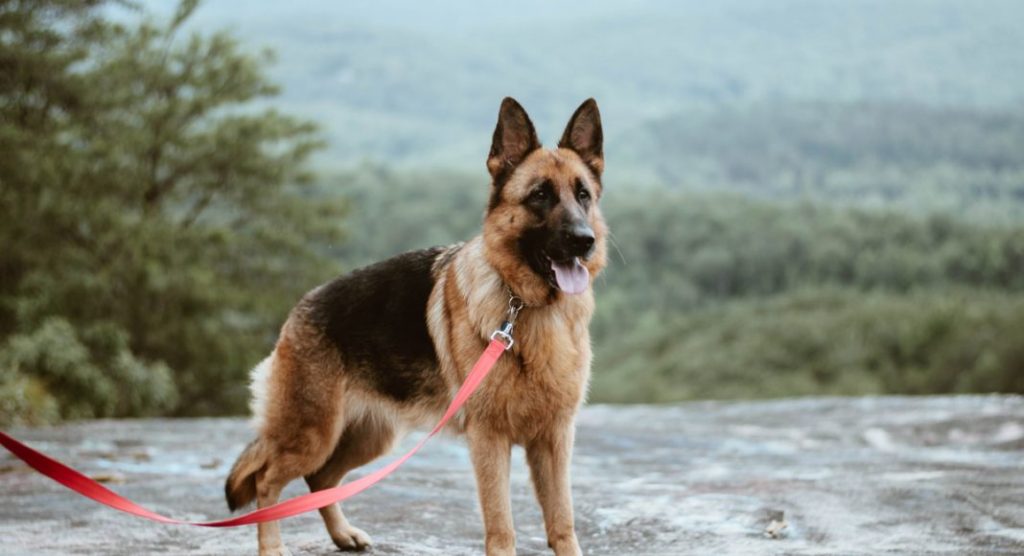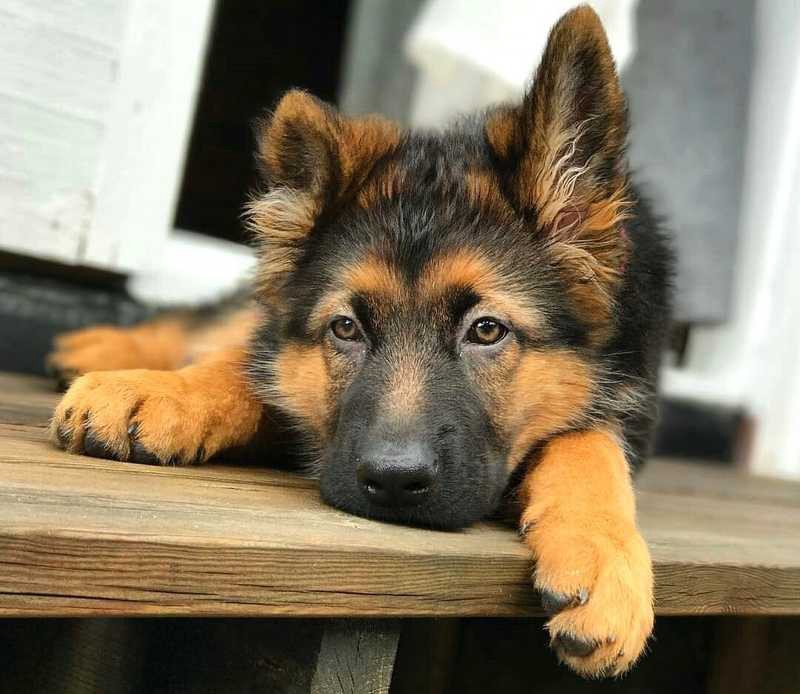The German Shepherd is a breed of medium to large-sized working dog that originated in Germany. In the English language, the breed’s officially recognized name is German Shepherd Dog (GSD). The breed was officially known as the Alsatian in the UK from after the First World War until 1977 when its name was changed back to German Shepherd. Despite its primitive, wolf-like appearance, the German Shepherd is a relatively modern breed of dog, with their origin dating to 1899.
As a herding dog, German Shepherds are working dogs developed originally for herding sheep. Since that time, however, because of their strength, intelligence, trainability, and obedience, German Shepherds around the world are often the preferred breed for many types of work, including disability assistance, search-and-rescue, police and military roles and acting. The German Shepherd is the second-most registered breed by the American Kennel Club and seventh-most registered breed by The Kennel Club in the United Kingdom.
Description

German Shepherds are medium to large-sized dogs. The breed standard height at the withers is 60–65 cm (24–26 in) for males, and 55–60 cm (22–24 in) for females. German Shepherds are longer than they are tall, with an ideal proportion of 10 to 8 1⁄2. The AKC official breed standard does not set a standard weight range. They have a domed forehead, a long square-cut muzzle with strong jaws, and a black nose. The eyes are medium-sized and brown. The ears are large and stand erect, open at the front, and parallel, but they often are pulled back during movement. A German Shepherd has a long neck, which is raised when excited and lowered when moving at a fast pace. The tail is bushy and reaches to the hock.
German Shepherds have a double coat that is close and dense with a thick undercoat. The coat is accepted in two variants; medium and long. The long-hair gene is recessive, making the long-hair variety rarer. Treatment of the long-hair variation differs across standards; they are accepted but not competed with standard coated dogs under the German and UK Kennel Clubs while they can compete with standard coated dogs, but are considered a fault in the American Kennel Club. The FCI accepted the long-haired type in 2010, listing it as the variety b—while the short-haired type is listed as the variety a.
Most commonly, German Shepherds are either tan/black or red/black. Most color varieties have black masks and black body markings which can range from a classic “saddle” to an over-all “blanket.” Rarer color variations include the sable, pure-black, pure-white, liver, silver, blue, and panda varieties. The all-black and sable varieties are acceptable according to most standards; however, the blue and liver are considered to be serious faults and the all-white is grounds for instant disqualification from showing in conformation at All Breed and Specialty Shows.
History

In 2018, a genetic study found that just prior to 1859, a broadly distributed European herding dog had given rise to the German Shepherd Dog, the French Berger Picard, and the five Italian herding breeds: the Bergamasco Shepherd, Cane Paratore, Lupino del Gigante, Pastore d’Oropa, and the Pastore Della Lessinia e del Lagorai.
Illustration of a German Shepherd from 1909
During the 1850s, attempts were being made to standardize dog breeds. Dogs were being bred to preserve traits that assisted in their job of herding sheep and protecting their flocks from predators. In Germany, this was practiced within local communities, where shepherds selected and bred dogs. It was recognized that the breed had the necessary skills for herding sheep, such as intelligence, speed, strength, and keen senses of smell. The results were dogs that we’re able to do such things, but that differed significantly, both in appearance and ability, from one locality to another.
To combat these differences, the Phylax Society was formed in 1891 with the intention of creating standardized development plans for native dog breeds in Germany. The society disbanded after only three years due to ongoing internal conflicts regarding the traits in dogs that the society should promote, some members believed dogs should be bred solely for working purposes, while others believed dogs should be bred also for appearance. While unsuccessful in their goal, the Phylax Society had inspired people to pursue standardizing dog breeds independently.
With the rise of large, industrialized cities in Germany, the predator population began to decline, rendering sheepdogs unnecessary. At the same time, the awareness of sheepdogs as a versatile, intelligent class of canine began to rise. Max von Stephanitz, an ex-cavalry captain and former student of the Berlin Veterinary College, was an ex-member of the Phylax Society who firmly believed dogs should be bred for working. He admired the intelligence, strength, and ability of Germany’s native sheepdogs, but could not find any one single breed that satisfied him as the perfect working dog.
In 1899, Von Stephanitz was attending a dog show when he was shown a dog named Hektor Linksrhein. Hektor was the product of a few generations of selective breeding and completely fulfilled what Von Stephanitz believed a working dog should be. He was pleased with the strength of the dog and was so taken by the animal’s intelligence, loyalty, and beauty, that he purchased him immediately. After purchasing the dog he changed his name to Horand von Grafrath and Von Stephanitz founded the Verein für Deutsche Schäferhunde (Society for German Shepherd Dogs). Horand was declared to be the first German Shepherd Dog and was the first dog added to the society’s breed register. In just a few decades of the Verein für Deutsche Schäferhunde’s establishment, the breed became one of the world’s most popular and numerous, a position it has maintained to this day. By 1923, the Verein für Deutsche Schäferhunde claimed 50,000 dues-paying members in more than 500 branches in Germany alone.
Horand became the center-point of the breeding programs and was bred with dogs belonging to other society members that displayed desirable traits and with dogs from Thuringia, Franconia, and Wurttemberg. Fathering many pups, Horand’s most successful was Hektor von Schwaben. Hektor was inbred with another of Horand’s offspring and produced Heinz von Starkenburg, Beowulf and Pilot, who later fathered a total of eighty-four pups, mostly through being inbred with Hektor’s other offspring. This inbreeding was deemed necessary in order to fix the traits being sought in the breed. In the original German Shepherd studbook, Zuchtbuch für Deutsche Schäferhunde (SZ), within the two pages of entries from SZ No. 41 to SZ No. 76, there are four WolfCrosses. Beowulf’s progeny also were inbred and it is from these pups that all German Shepherds draw a genetic link. It is believed the society accomplished its goal mostly due to Von Stephanitz’s strong, uncompromising leadership, and he is therefore credited with being the creator of the German Shepherd Dog.
Adolf Hitler acquired a German Shepherd named “Prinz” in 1921, during his years of poverty, but he had been forced to lodge the dog elsewhere. However, she managed to escape and return to him. Hitler, who adored the loyalty and obedience of the dog, thereafter developed a great liking for the breed. Holocaust victim Benjamin Jacobs described running away from German Shepherd dogs who harassed his family at Auschwitz extermination camp, where over 1 million people were murdered. During the first half of the twentieth century, the Shepherd Dog came to be strongly identified with Imperial and Nazi Germany, because of the breed’s association with purity and militarism.
